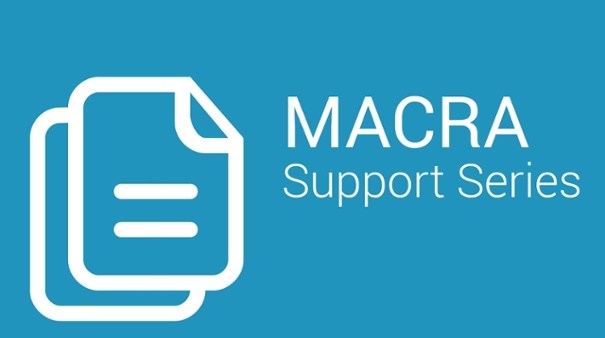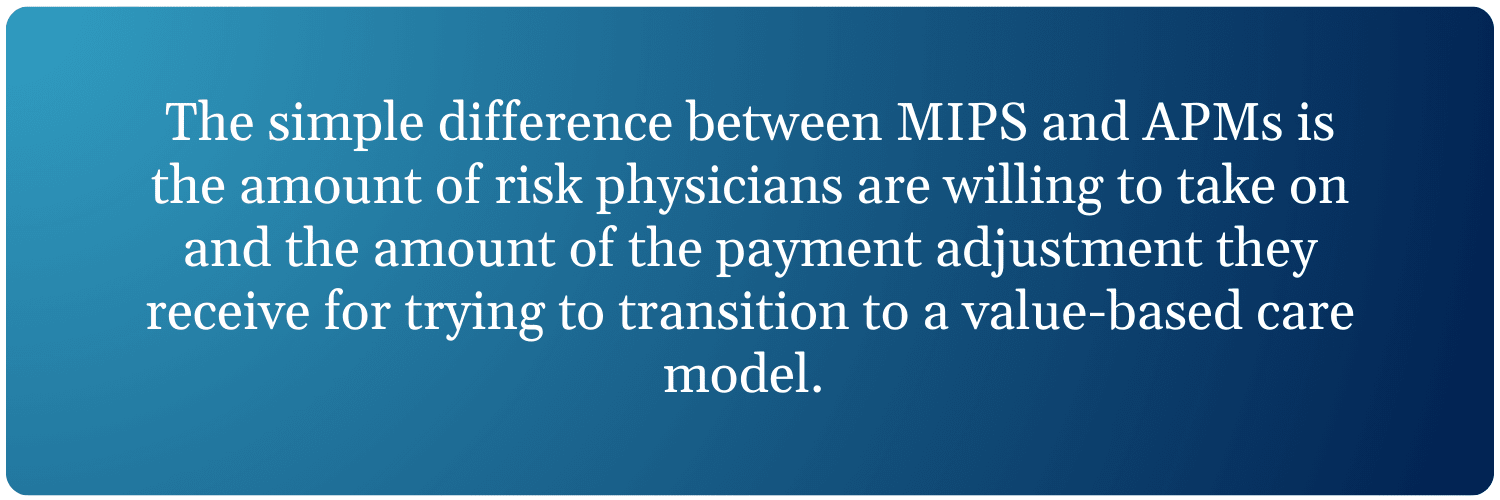MIPS Vs APM: How to Balance Risk, Bonuses, and Exemptions

APM stands for Alternative Payment Model, while MIPS stands for Merit-Based Incentive Payment System. The verification process for health care providers should begin this year, and the first payments under these systems will be made in 2019.
There are two different tracks for the Medicare Access and CHIP Reauthorization Act of 2015 (MACRA). The first, the Quality Payment Program consolidates current fee-for-service Medicare programs (Meaningful Use, Physician Quality Reporting System, and Value-Based Payment Modifier) into a single program called MIPS – Merit-based Incentive Payment System. The second is applied to clinicians who are exempt from participating in MIPS because they are a qualified participant in an APM, which is called the Advanced Alternative Payment Models (APMs).

MIPS:
MIPS is a performance-based payment system composed of four categories that provide clinicians the flexibility to choose the activities and measures that are most meaningful to their practice. An eligible clinician’s performance in each of the four weighted performance categories is combined to create the MIPS Composite Performance Score, also known as the MIPS Final Score, which is used to determine Medicare Part B payment adjustments in future years.
The four performance categories for MIPS are:
- Quality (measurements like PQRS)
- Practice Improvement (transforming operational process)
- Advancing Care Information (rebrand of Meaningful Use)
- Resource Use or Cost (The Final Rule removed the Resource Use requirement for this year but it will be increased in the following years)
Each category is weighted as follows: Quality 60%, Practice Improvement 15%, Advancing Care Information 25%, Resource Use 10%
Based on the MIPS Composite Performance Score, physicians will receive +/- or neutral adjustments up to the following percentages:
2019: -4% to 4%
2020: -5% to 5%
2021: -7% to 7%
2022+: -9% to 9%
APMs:
The Advanced APM path is for providers who take on added risks when treating their patients while delivering high-quality, coordinated, and efficient care.
To be an Advanced APM the three criteria must be met:
- Require participants to use certified electronic health record technology
- Provide payment for covered professional services based on quality measures similar to those used in the quality performance category of the Merit-based Incentive Payment System (MIPS) and
- Either: (1) be a Medical Home Model expanded under CMS Innovation Center authority; or (2) require participating APM Entities to bear more than a nominal amount of financial risk for monetary losses.
Once physicians are participating in an Advanced APM, they can earn the 5% incentive payment in 2019 for Advanced APM participation in 2017 if:
– Physicians receive 25% of their Medicare Part B payments through an Advanced APM
or
– See 20% of their Medicare patients through an Advanced APM
In order to meet Advanced APM Qualifying Participation requirements, you’ll also need to send in the quality data required by your Advanced APM.
If a physician decided to leave the Advanced APM in 2017 they should try to meet the Advanced APM requirements for that year to receive the 5% bonus. If they cannot meet these requirements they will need to submit data to be a part of the MIPS program, otherwise, they will be subject to the -4% payment adjustment in 2019.
The simple difference between MIPS and APMs is the amount of risk physicians are willing to take on and the amount of the payment adjustment (being positive or negative) they receive for trying to transition to a value-based care model. While participating in an APM you are taking on more risk as a physician or practice and for that you are rewarded with a 5% bonus if you meet those requirements, while being enrolled in MIPS you need to submit your data demonstrating your performance in the transition to value-based care, your reporting data is then scored; a higher score indicates earning payment incentives and a lower or no score indicates a paying a penalty.
These tracks are both better suited for larger practices and organizations because they will have more resources to make sure that they can keep up with the requirements for both MIPS and Advanced APMs. However, some independent primary care physicians may be exempt if it’s their first year excepting Medicare payments or if they bill less than $30,000 in Medicare per year or see fewer than 100 Medicare patients. As of 2017, virtual groups (which allow physicians of small or solo practices to pull their resources together so they can participate in the QPP) will not be implemented but CMS is planning on implementing the groups in 2018.
